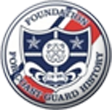- Announced Annual Awards:
- Large Unit History Award Winner (with dedicated Public Affairs Staff): Commander, First Coast Guard District. The First District compiled an impressive array of accomplishments in remembrance of the history of the units that comprise the district. Aside from creating a District History and Heritage Plan, the staff hosted multiple outreach events, created multimedia projects for sharing online, and contributed significantly to the national campaign for the War of 1812 Bicentennial. Most importantly for the judges, they focused heavily on internal audiences, sharing their history with their shipmates throughout the region.
- Large Unit History Award Winner (without dedicated Public Affairs Staff): Commander, Sector Buffalo. Sector Buffalo worked with the Buffalo Lighthouse Association and local congressional staff to renovate and open public access to the 1833 Buffalo Lighthouse, while still maintaining an effective security perimeter. Additionally, Sector Buffalo, in cooperation with the Sector Buffalo Chiefs’ Mess and Lightship Sailors Association, funded and dedicated a memorial site for the wreck of the U.S. Lightship Service LV-82 at Point Albino, Ontario, Canada. Sector Buffalo also played a major role in celebrating U.S. Coast Guard history and promoting current missions at the war of 1812 Bicentennial commemoration in Cleveland, Ohio, and Buffalo, New York.
- Small Unit History Award Winner: USCGC Richard Etheridge. The crew of the newly commissioned fast response cutter shared the story of the hero for whom their cutter was named through more than 20 print, radio, and television availabilities. They hosted a two-day event bringing together authors and documentarians who have told the Etheridge story, and worked with several museums on the outer banks of North Carolina, where Etheridge served with the U.S. Life-Saving Service. The crew also worked with the cutter’s sponsor to obtain floorboards from the home of Adam Etheridge, where Richard lived as a young slave; those floorboards were converted to port and starboard name boards now used on the cutter.
- Book awards.
- Coast Guard Heritage: Dr. Dennis L. Noble, USCG (ret.) for his book The U.S. Coast Guards War on Human Smuggling. The judges described his book as an innovative, intensive look at one of the Coast Guards newest missions, a book on which all future titles on the subject will stand. They also cited his unprecedented contribution to the field of Coast Guard history.
- Alan Giagnocavos: A Close up Look: A Tour of Americas Iconic Architecture Through Historic Photos and Detailed Drawings. The judges called this book a clear winner, offering a universal perspective in its review of 18 lighthouses through the use of Historic American Buildings Survey (HABS) and Historic American Engineering Record (HAER) files.
- Heritage Award:
- Jennifer Gaudio, curator of the U.S. Coast Guard Museum, located at the U.S. Coast Guard Academy. Ms. Gaudio led a $450,000 year-long redesign and renovation of the Coast Guard Museum. Apart from the tasks of designing and installing exhibits, Ms. Gaudio ensured that the exhibits were not only appealing, interesting, and effective, but also portable, for potential future use in a new National Coast Guard Museum. To effect this change, Ms. Gaudio worked with a private design firm, cadets, staff, alumni, and Auxiliary, and encouraged an increased visitorship to the museum upon completion of the exhibits.
- William J. Nelson, USCG Auxiliary. Auxilarist Nelson, assigned to the Atlantic Area staff, served as the principal War of 1812 historical research specialist detailed to the Atlantic Area Historian’s office and independently began research on the travails of Revenue Cutter Service prisoners of war taken during that war. Among his many accomplishments during the extended period of research was the innovative design of a portable exhibit carried onboard USCGC Eagle during its 2012 port calls.
- LT Galen Varon, USCG. During off-duty time, LT Varon codified the history of the 15 cutters that have historically been called Queen of the Fleet since 1896. He has developed individual websites for each one, and brought them together under a common website, http:www.the-royal-court.info. He has also written a 191-page manuscript on one of these cutters, USCGC Storis.
- Supported the CG Public Affairs Program and the Historian’s Office by chairing a meeting held to evaluate and baseline the current historical program, identify any shortcomings in the program, and offer suggestions for improvement. In attendance and providing input were CG history stakeholders including professional historians, leaders of non-governmental USCG-related historical organizations, authors of USCG-related publications, and governmental and non-governmental museum professionals. The group compiled a detailed description of the characteristics of the desired CG history program and developed a list of ten goals to achieve the desired end state. The goals were categorized into 1, 2, and 5-year groups. Broadly grouped, they focus on using non-appropriated support, increasing visibility of the program, and updating/developing new policy in support of the program.
- Worked with City of Sturgeon Bay, Wisconsin, to develop three USCG-specific informational reader boards highlighting local CG history. Boards are part of a series installed in two waterfront parks. Regent CAPT Bob Desh, USCG (Ret.) researched historic photos and authored all text.
- Continued sponsorship of Coast Guard History Award to Honor Graduate of each Chief Warrant Officer Professional Development Class.
- Published three editions of The Cutter, FCGH’s magazine.
